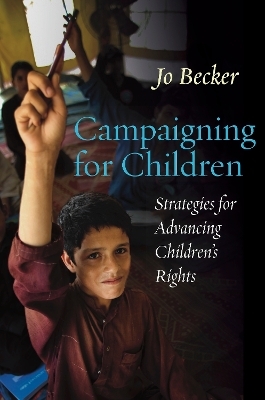
Campaigning for Children
Stanford University Press (Verlag)
978-1-5036-0190-1 (ISBN)
Campaigning for Children focuses on contemporary children's rights, identifying the range of abuses that affect children today, including early marriage, female genital mutilation, child labor, child sex tourism, corporal punishment, the impact of armed conflict, and access to education. Jo Becker traces the last 25 years of the children's rights movement, including the evolution of international laws and standards to protect children from abuse and exploitation. From a practitioner's perspective, Becker provides readers with careful case studies of the organizations and campaigns that are making a difference in the lives of children, and the relevant strategies that have been successful—or not. By presenting a variety of approaches to deal with each issue, this book carefully teases out broader lessons for effective social change in the field of children's rights.
Jo Becker is Advocacy Director for the Children's Rights Division at Human Rights Watch and Adjunct Associate Professor of International and Public Affairs at Columbia University. Her first book, Campaigning for Justice (Stanford, 2012), won the APSA Human Rights Section Best Book Award in 2014.
Contents and Abstracts1From Property to People: The Evolution of Children's Rights chapter abstractThis chapter provides an overview of the children's rights movement, with a focus on the last twenty-five years, including the development of international standards, the Convention on the Rights of the Child, and the evolution of the children's rights agenda.
2Female Genital Mutilation/Cutting chapter abstractThis chapter explores the practice of female genital mutilation/cutting (FGM/C), a practice that has affected an estimated 200 million girls and women in at least 30 countries. The chapter explores its prevalence, the factors that perpetuate the practice, its health impacts on women and girls, and successful efforts by organizations like Tostan and Kembatti Mentti Gezzima (KMG) to utilize community dialogue to encourage local villages to voluntarily abandon the practice.
3Juvenile Justice chapter abstractThis chapter explores juvenile justice practices, and the failure of states to fulfill international obligations to utilize detention only as a last resort, and for the shortest possible period of time. Many states detain children for petty offenses, and subject children in conflict with the law to cruel and punitive treatment and excessive sentences. The chapter explores in particular juvenile justice legal reforms in South Africa that dramatically reduced the number of children in detention, and the successful effort in the United States to abolish the juvenile death penalty.
4Child Marriage chapter abstractThe chapter explores the global phenomenon of child marriage. Worldwide, an estimated 15 million girls a year—39,000 a day—are married before they turn 18, resulting in heightened risk of domestic violence and HIV, higher rates of early pregnancy and maternal mortality, and lower educational achievement. The chapter explores the factors that perpetuate child marriage, as well as programs and initiatives that have been successful in keeping girls in school and delaying marriage. The work of the Girls Not Brides campaign is examined in particular.
5Child Labor chapter abstractThe chapter explores child labor worldwide, which affects an estimated 168 million children, including 85 million involved in hazardous work that threatens their health or safety. The chapter examines the factors that perpetuate child labor, and interventions – such as cash transfer policies and incentives to boost school enrolment – that have successfully reduced child labor. The chapter also looks at civil society efforts to address child labor, including the work of Bachpan Bachao Andolan to establish "child-friendly villages" in India, the influence of the Global March against Child Labor in the adoption of new international labor standards to end the worst forms of child labor, cross-sectoral efforts to address child labor in El Salvador's sugarcane sector, and consumer-based campaigns that secured pledges from the world's largest chocolate companies to eliminate child labor from their products.
6Corporal Punishment chapter abstractThis chapter explores the physical or corporal punishment of children. An estimated 80 percent of children between the ages of 2 and 14 – approximately 1 billion globally – experience physical punishment in their home on a regular basis. The chapter examines the long-term affects of corporal punishment, including increased aggression, anxiety, and depression, lower IQ scores and school performance, and low levels of self-esteem. In particular, the chapter examines the work of the Global Initiative to End Corporal Punishment of Children, which has helped to quadruple the number of states prohibiting all corporal punishment of children, from 11 in 2001 to 49 in 2016, with an additional 57 states committed to prohibition. The chapter also explores a contentious national campaign in New Zealand to legally prohibit corporal punishment of children.
7Child Sex Tourism chapter abstractThis chapter explores how the rapid expansion of global tourism has fueled the sexual exploitation of children in travel and tourism (often referred to as "child sex tourism"), with increasing numbers of people travelling locally or internationally to engage in sexual activities with children. In particular, the chapter examines the work of ECPAT, a global network to end child prostitution, child pornography and trafficking of children for sexual purposes; the development of the "Code of Conduct for the Protection of Children from Sexual Exploitation in Travel and Tourism" to engage the travel industry in efforts to combat child sex tourism; and experiences in Costa Rica in utilizing the Code to heighten awareness of child sex tourism and to address it.
8Child Soldiers chapter abstractThis chapter explores the recruitment and use of children as soldiers by government armies and non-state armed groups in armed conflicts. It examines the many reasons that children are recruited as soldiers, global trends, and the development of national and international law to prevent and end the use of child soldiers. In particular, it examines the efforts of the UN Security Council and the Watchlist on Children and Armed Conflict to address violations against children in armed conflict, and the advocacy campaign for a US law to prohibit US military assistance to governments implicated in the recruitment or use of child soldiers.
9Access to Education chapter abstractThis chapter examines children's right to education. Education is arguably the most powerful catalyst for improving children's lives. Children who are in school are less likely to end up in child labor, child marriage, or as child soldiers, and are more likely to enjoy better health, better job prospects, and higher earnings as adults. Yet 124 million children were out of school in 2014, due to armed conflict, school-related costs, discrimination, violence, or lack of teachers and school facilities. The chapter examines successful initiatives to boost school enrolment and reduce drop-out rates, including civil society campaigns to realize the right to education, including organizing by children to achieve free education in post-war Sierra Leone, and worldwide mobilization by the Global Campaign for Education.
10Attacks on Education chapter abstractThis chapter examines attacks on education during armed conflict, including attacks on schools, teachers, and students, and the use of schools for military purposes. In particular, it examines the work of the Global Coalition to Protect Education from Attack and a global campaign to secure commitments from government not to use schools for military purposes.
11Lessons for the Future chapter abstractThis chapter concludes the book by highlighting the strategies that can advance children's rights. At a policy level, it finds that effective interventions include strong laws, coupled with effective enforcement, and sound policies that provide children and their families with access to essential services. Based on the case studies examined in the book, the chapter also highlights the strategies that help civil society campaigns for children success, including research and documentation, strategic messaging, community dialogue, coalition-building, grassroots engagement, legal reform, and use of the courts and UN human rights mechanisms.
| Erscheinungsdatum | 23.08.2017 |
|---|---|
| Verlagsort | Palo Alto |
| Sprache | englisch |
| Maße | 152 x 229 mm |
| Themenwelt | Recht / Steuern ► EU / Internationales Recht |
| Recht / Steuern ► Öffentliches Recht ► Verfassungsrecht | |
| Sozialwissenschaften ► Politik / Verwaltung ► Politische Theorie | |
| ISBN-10 | 1-5036-0190-0 / 1503601900 |
| ISBN-13 | 978-1-5036-0190-1 / 9781503601901 |
| Zustand | Neuware |
| Haben Sie eine Frage zum Produkt? |
aus dem Bereich


